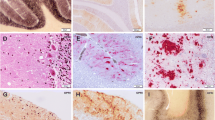Prion protein (PrP) is intimately linked with a class of neurodegenerative diseases known as transmissible spongiform encephalopathies (TSEs). Employing bioinformatics and direct molecular analysis, we demonstrated that the human PrP gene (PRNP) locus, which is situated at Chromosome (Chr) position 20p12-ter, contains three genes within a 55-kb interval: PRNP; DOPPEL or PRND, located 20 kb 3? of PRNP; and a novel gene, designated PRNT, that maps 3 kb 3? to PRND and is transcribed to generate at least three alternatively spliced mRNAs. All three genes of this locus demonstrate low sequence homology, implying that, although they may be evolutionarily related, they are functionally distinct. Analysis of both adult and fetal human tissues confirmed the ubiquitous but variable expression profile of PRNP, with the highest levels observed in the CNS and testis. Contrastingly, although PRND shows a wide tissue expression pattern in fetal tissues, it is expressed exclusively in adult testis, whereas all three PRNT isoforms were detected only in adult testis, implying that PRND is developmentally regulated. An investigation of the regulatory mechanisms underlying this complex gene expression pattern from the PRNP locus should provide insight into the function of these genes and the possible involvement of the non-PrP proteins in the development of TSEs.
Similar content being viewed by others
Author information
Authors and Affiliations
Rights and permissions
About this article
Cite this article
Makrinou, E., Collinge, J. & Antoniou, M. Genomic characterization of the human prion protein (PrP) gene locus . Mamm Genome 13, 696–703 (2002). https://doi.org/10.1007/s00335-002-3043-0
Received:
Accepted:
Issue Date:
DOI: https://doi.org/10.1007/s00335-002-3043-0




